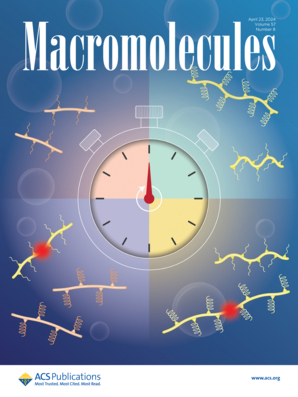室温固化非异氰酸酯聚氨酯胶粘剂和涂料的无溶剂合成
IF 5.2
1区 化学
Q1 POLYMER SCIENCE
引用次数: 0
摘要
由于异氰酸酯的使用给人类健康带来很高的风险,近年来实施了关于使用这些化学品的新条例,以改善工作场所的健康和安全标准。相应地,聚合物化学家的注意力正迅速从传统的聚氨酯(pu)转向更可持续和更安全的非异氰酸酯聚氨酯(nipu)。对于粘合剂和涂料等应用,无溶剂NIPU配方具有吸引力,因为它们减少了对环境的影响,并且在消费品应用中具有使用潜力,但由于通常应用的环状碳酸盐前驱体的反应性较低,固化通常需要外部热源。本文报道了无溶剂和室温固化的NIPU胶粘剂和涂料。设计了双组分(2K) NIPU配方,利用液态co2源双(α-烷基基环碳酸酯)单体的反应活性,在无溶剂条件下与低粘度多胺交联剂聚合。通过在混合物中加入助试剂,使聚合物网络的化学结构多样化。在不同的固化时间下对热固性材料的性能进行了评价,结果表明,经过1天的室温硬化后,铝接头的附着力已经很高。在不同的基质上测试了粘合性能,在将儿茶酚基掺入聚合物基质后进一步评估了粘合性能,并与商用无溶剂PU胶进行了基准测试。易于操作,延长锅寿命,可忽略VOC,在低温下快速固化,使新的2K配方成为异氰酸酯基产品的有竞争力的替代品,为新的室温nipu基粘合剂和涂料铺平了道路。本文章由计算机程序翻译,如有差异,请以英文原文为准。

Solvent-free Synthesis of Room-Temperature Curable Nonisocyanate Polyurethane Adhesives and Coatings
Because of the high risks to human health that arise from the use of isocyanates, new regulations concerning the use of these chemicals were implemented in recent years to improve health and safety standards in the workplace. Correspondingly, the attention of polymer chemists is rapidly shifting from conventional polyurethanes (PUs) to more sustainable and safer nonisocyanate polyurethanes (NIPUs). For applications such as adhesives and coatings, solvent-free NIPU formulations are attractive due to their reduced environmental impact and their potential for use in consumer good applications, but curing typically requires an external heat source due to the low reactivity of the typically applied cyclic carbonate precursors. In this work, solvent-free and ambient-temperature-curing NIPU adhesives and coatings are reported. Two-component (2K) NIPU formulations were designed, exploiting the increased reactivity of a liquid CO2-sourced bis(α-alkylidene cyclic carbonate) monomer, which was polymerized with a low-viscosity polyamine cross-linker under solvent-free conditions. The composition was varied, adding coreagents to the mixture to diversify the chemical structure of polymer networks. The properties of the thermosets were evaluated at different curing time, revealing high adhesion on aluminum joints already after 1 day of room-temperature hardening. The bonding performance was also tested on different substrates, further evaluated after the incorporation of catechol groups into the polymer matrix, and benchmarked against commercial solvent-free PU glues. The easy handling, prolonged pot life, negligible VOC, and fast curing at low temperature make the new 2K formulations a competitive alternative to isocyanate-based products, paving the way to new room-temperature NIPU-based adhesives and coatings.
求助全文
通过发布文献求助,成功后即可免费获取论文全文。
去求助
来源期刊

Macromolecules
工程技术-高分子科学
CiteScore
9.30
自引率
16.40%
发文量
942
审稿时长
2 months
期刊介绍:
Macromolecules publishes original, fundamental, and impactful research on all aspects of polymer science. Topics of interest include synthesis (e.g., controlled polymerizations, polymerization catalysis, post polymerization modification, new monomer structures and polymer architectures, and polymerization mechanisms/kinetics analysis); phase behavior, thermodynamics, dynamic, and ordering/disordering phenomena (e.g., self-assembly, gelation, crystallization, solution/melt/solid-state characteristics); structure and properties (e.g., mechanical and rheological properties, surface/interfacial characteristics, electronic and transport properties); new state of the art characterization (e.g., spectroscopy, scattering, microscopy, rheology), simulation (e.g., Monte Carlo, molecular dynamics, multi-scale/coarse-grained modeling), and theoretical methods. Renewable/sustainable polymers, polymer networks, responsive polymers, electro-, magneto- and opto-active macromolecules, inorganic polymers, charge-transporting polymers (ion-containing, semiconducting, and conducting), nanostructured polymers, and polymer composites are also of interest. Typical papers published in Macromolecules showcase important and innovative concepts, experimental methods/observations, and theoretical/computational approaches that demonstrate a fundamental advance in the understanding of polymers.
 求助内容:
求助内容: 应助结果提醒方式:
应助结果提醒方式:


